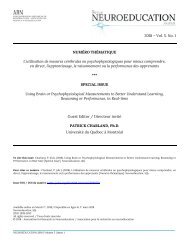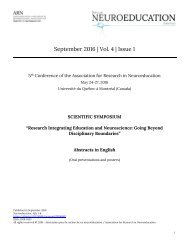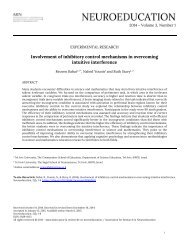Neuroeducation_2012_vol-1_no-1_full
Neuroeducation journal - Volume 1, Issue 1 (2012) - 144 pages
Neuroeducation journal - Volume 1, Issue 1 (2012) - 144 pages
Create successful ePaper yourself
Turn your PDF publications into a flip-book with our unique Google optimized e-Paper software.
EXPERIMENTAL RESEARCH<br />
Bridging the gap between cognitive neuroscience and<br />
education: Psychophysiological and behavioral data<br />
collection in authentic contexts<br />
https://doi.org/10.24046/neuroed.<strong>2012</strong>0101.5<br />
Julien MERCIER 1, *, Pierre-Majorique LÉGER 2 , Caroline GIRARD 1 , and<br />
Jan-Sébastien DION 1<br />
1<br />
Université du Québec à Montréal<br />
2<br />
HEC Montréal<br />
* Email: mercier.julien@uqam.ca<br />
Abstract<br />
Psychophysiological correlates of learning and performance are currently<br />
viewed as an important source of information for the improvement of many<br />
spheres of human activity, including the field of education. Studies in<br />
neuroeducation are likely to benefit from the concomitant analysis of different<br />
levels in the cognitive architecture (psychophysiological, cognitive, and social<br />
cognitive). The case study reported herein is concerned with the<br />
psychophysiological and cognitive levels. The objective is to test a methodology<br />
permitting, on the one hand, to relate data from EEG and data from a thinkaloud<br />
procedure collected simultaneously during the performance of a problemsolving<br />
task in a semantically-complex domain and, on the other hand, to test<br />
hypotheses regarding functional relationships between those levels. During a<br />
two-hour experiment, a single participant planned remedial reading activities on<br />
the basis of a description of a student having reading difficulties. The procedure<br />
for data preparation is presented. Then, as an illustration of the methodology,<br />
hypotheses in<strong>vol</strong>ving both levels are tested. Results show that the methodology<br />
can establish correlational relations between targeted levels in terms of cooccurrence<br />
of cognitive and psychophysiological states. They also show that an<br />
EEG trace transformed into 1-second intervals characterizing brain states is <strong>no</strong>t<br />
sufficiently fine-grained to test causal relationships based on the temporality of<br />
the data. This study stresses the need to explore the phe<strong>no</strong>me<strong>no</strong>n of rapidlytransitioning<br />
psychophysiological microstates in the context of neuroeducational<br />
research.<br />
ISSN: 1929-1833 © <strong>2012</strong> <strong>Neuroeducation</strong> - December <strong>2012</strong> | Volume 1 | Number 1<br />
5








